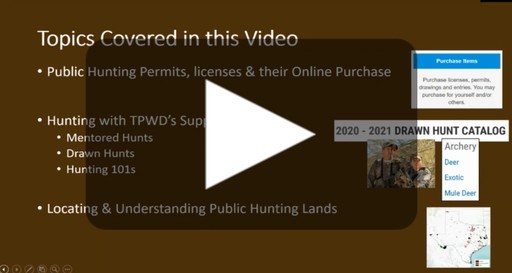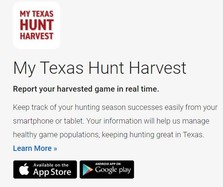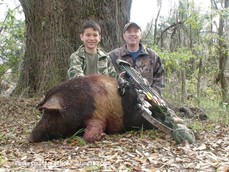Bowhunter by Fall
July - Scouting and Finding a Place to Hunt
Hello future bowhunters! Since June's edition, we hope that you have taken some time to talk about your hunting adventure with a mentor, collected some gear, and put that gear to use in some target practice. To stay on the track it is time to think about where you can hunt and starting to try to pick your hunting spot. You can do that work from a computer screen or by getting your boots dirty. There is plenty of social distance to be found on public hunting lands!
Where to Hunt - Programs and Public Lands
If you or your family does not own land suitable for hunting, it is easy to think that hunting may not be in your future. Thankfully, the Texas Parks and Wildlife Department has options to provide you access and educational resources too!
Watch the video below to learn about Public Hunting Permits & Licenses, programs including Mentored Hunts, Drawn Hunts, and Hunting 101 Classes, and tips for accessing the one million acres of public and private lands in Texas available to you for your new bowhunting adventures! After the video, start here to see each of these and more!
 |

E-scouting and Apps
When you have identified a place you wish to hunt, you will need to decide where you specifically will find the game you are targeting.
It starts with “E-Scouting”, a common and unofficial term for using electronic resources, apps, websites, social media and communication to give you an overview of the property and hunting locations. Using those tools, you can filter out areas of the property that will likely be unproductive for hunting while highlighting the areas that provide the best opportunity for game encounters. Once you’ve done this, you should physically go to the property ahead of the hunting season to test your theories and scout, looking for deer sign that will indicate where they will be during the hunting season. This will provide you with further information to come up with a hunting plan for opening day well as familiarize yourself with the terrain. When you combine E-Scouting with in-person scouting you enable yourself to come up with a plan for success.
|

You can find the hunting property on TPWD's "Interactive locator map". Now, find that same property on your favorite mapping website or via paper maps. This confirms that the property is within your travel area and provides you a route. Further, confirm the access points to the property and enter from approved locations. These access points often require on-site registration (OSR), and usually provides an information station. You can also complete your OSR online or via the Hunt Harvest app as well. This app provides many additional features to keep track of your hunting history and connect to your social media too! The information provided at the information station can also be found online here via the “Download Map Booklet” link from the blue “Get Started” banner.
|

But where in that property should you hunt?
If available, use satellite or terrain/topographic views in your mapping. The terrain view will help you visualize the hills, valleys, stream beds, cliffs, saddles, spurs, ridges and other features that influence deer movement and the likelihood of food and cover deer use. The decisions made by deer may be dictated by the season. Check those links for further explanation and help your game planning. Use these visuals to help you further understand what these terrain features look like on a topographical map.
The satellite view gives you more clues about the vegetation present in the habitat as well as water, trails, fires and human activity (logging, farming, construction, etc.). Some resources show satellite views from different time periods which can tell you if a fire a few years ago has produced an area of increased sunlight exposure creating new vegetation growth that deer may be feeding on, if an area has a history of flooding, help you identify hardwood trees from evergreens, etc. Most importantly satellite imagery helps you see changes in the habitat, or what deer hunters refer to as “transition zones” or “edge habitat”.
|

Typical Habitat
Deer are edge-oriented animals. “Edge” is created when two or more habitats or features meet, and the edge is where you want to be. The edge could be where a deer can emerge from a cedar thicket area that provides security into an open meadow with fresh green growth to feed on, because the deer can retreat to the cedar if needed. Edge can be a dry, gnarly creek bed that borders a corn field or other agriculture crop. Derelict, overgrown roads on public land are often lush with summer vegetation and framed by flood zones that create security for deer. If you find edge that intersects with a third habitat or feature, it makes that intersection even more likely to direct deer movement. This could be a bend in a river that swings closer to a road and funnels deer through that area, or a relatively low spot between two hills (also known as a “saddle”).
Cross referencing the property boundary map, topographic/terrain map and satellite imagery will give you a more holistic view of the property. Based on this, mark the edges, transition zones, terrain features, likely food, cover and water locations on your map, GPS or mobile device app so you can scout them out in person.
|

Helpful Tools
GPS units are a great tool. They can be simple, with the single purpose of accurately depicting your location or advanced, allowing you to mark locations, plan routes, provide weather conditions and other details that can be helpful to a bowhunter. Because of the wide selection, spend some time exploring your options if you are interested in a dedicated GPS device. Be advised, cell service may be limited at remote hunting properties. While the GPS function of your phone should still work, it will not be a benefit to you if you do not have the map pre-downloaded to your device. True handheld, dedicated GPS devices may be a good alternative.
|

Apps for your phone are also varied and can be very useful to the modern bowhunter. These apps provide mapping tools, satellite imagery, the ability to mark points or plan routes and some indicate property boundaries and landowner contact information to make sure you are safe, legal and ethical out in the field. Most mapping and hunting apps are FREE, however, may offer in-app purchases. Take some time to research the app store for reviews and determine which app best meets your needs and budget. Consider weather-specific apps, too. Knowing specific sunrise and sunset times are critical to your hunting plan in order to adhere to legal shooting hours, so an app with that feature helps. Of course, load up the official TPWD apps of “My Texas Hunt Harvest” and “Outdoor Annual” as well. You can even take a picture of your hunting license and photo ID and store them on your phone. Always download and install apps before going to the hunt property as signal strengths vary.
Based on your analysis of topo/terrain, satellite imagery, mobile apps, and your instincts, make some marks on your map and plan routes to explore the property you intend to hunt. Lace up your boots and get in the woods, and physically visit the areas that drew your interest to see if you find evidence of deer where you expect it. Also keep an eye out on your way to your destination because unforeseen hotspots can reveal themselves to you, and a chance encounter with an animal can indicate a bedding or feeding area. Mark these locations on your map or device and add it to your understanding of the area.
|

What are you looking for?
Tracks, droppings, scrapes, rubs and beds. Each of these links offers explanation of signs of game that suggest deer are in the area. The more time you spend on the property the more signs you will find. Record it, note how fresh it was and when it was found. This starts to give you more clues as to when and what animals came through the area. As you advance as a bowhunter you can research how to discriminate between buck and doe signs, immature vs. mature buck signs and other elite level skills. Try a quick game to confirm what you think you already know.
Now that your map is all marked up with areas indicating a lot of deer activity, identify your top three or four choices based on your scouting, research and your own instincts. You may also factor in where and how you will access the property to get to these ambush spots. Conditions, like wind direction, on your hunt may prompt you to switch between these spots. Therefore, it’s good to have multiple hunt locations to choose from.
Understand that some signs you find in summer may not be as timely or as applicable as it may be during the hunting season and that you may discover totally new sign once the season begins. This means you will constantly need to adapt, but it gives you a great starting location as you take one more major step towards bowhunting by Fall.
|

What About Hogs?
Besides being made into great tacos, they are a great game species and you would be doing Texas a favor by removing an invasive species.
With the hog season being open year-round, it affords you a hunting opportunity whenever it fits in your schedule, even while you’re scouting for the upcoming deer season. Take your bow and look for opportunities to spot and stalk feral pigs. Check this link for more information on the destruction caused by hogs, and few tips for your hunt. The author describing his hunt may also stoke your fire for a hog hunt adventure. Many public hunting lands that allow deer hunting also allow hunting for feral pigs. Be sure to confirm the regulations for that particular property. This link provides answers to many of the FAQs about hog hunting and offers advice on the signs of hogs in the area and differentiating between hogs and deer.
|

Remember our friends at Bowhunting360.com too! They have a wealth of information to help you understand scouting even further!
|
We hope that you are getting as excited as we are! The fall hunting season brings with it cooler weather, but the bowhunting action starts to heat up! Be sure you are putting arrows in targets and continuing to get better each week! The best harvests are with a perfectly placed shot. We will be back in August with more help and suggestions for practicing.
Do you have a friend who you would like to share this campaign with? Share this link with them, and we will catch them up to speed.
If you haven't yet, please take our 3 minute survey to tell us a little about yourself. Your responses will help us make the information more relevant to you!
TPWD's Community Archery Team
Texas Parks and Wildlife Department
(512)389-4361 (office)
Robert.Owen@tpwd.texas.gov
|